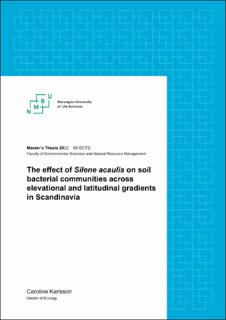| dc.description.abstract | Microbes are ubiquitous, extremely diverse, and contribute to important ecosystem functions. Soil bacterial communities, in particular, play an important role in carbon and nutrient cycling, through decomposition and carbon sequestration. In addition, soil bacteria establish mutualistic relationships with plants, animals and other microorganism.
However, soil microbial communities may change in diversity and composition in response to changes in climate, which may disrupt the interactions between soil microbes and other organisms, such as plants. The impact of climate change in arctic and alpine environments is expected to be disproportionately large, thus it is important to understand how soil microbial communities in these environments respond to changes in temperature, precipitation, and plant communities. The alpine cushion plant Silene acaulis, is a dominant, foundational species known for its facilitative effects in stressful environments. There have been several studies investigating the facilitative effects of cushion plants on other plants. However, less in known about the relationship between cushion plants and their soil microbiome.
Here, I investigated the effect of S. acaulis on its soil bacterial community. I also investigated the effect of latitude and elevation on the soil bacterial communities in rhizosphere of S. acaulis, as proxies for climate change. I found that S. acaulis had a significant effect on the soil bacterial community composition. Along the elevational gradient, soil microbial communities under S. acaulis decreased in richness with increases in elevation. There was a significant effect from latitude on the bacterial composition. However, it appears that site specific factors, such as pH, are more influential along the latitudinal gradient. S. acaulis may have a converging effect on the soil bacterial community composition along environmental gradients, and as such, the direct effects of climate change may be weak. Further research is needed to better understand the relative importance of the different factors driving soil bacterial communities in alpine environments. | en_US |

